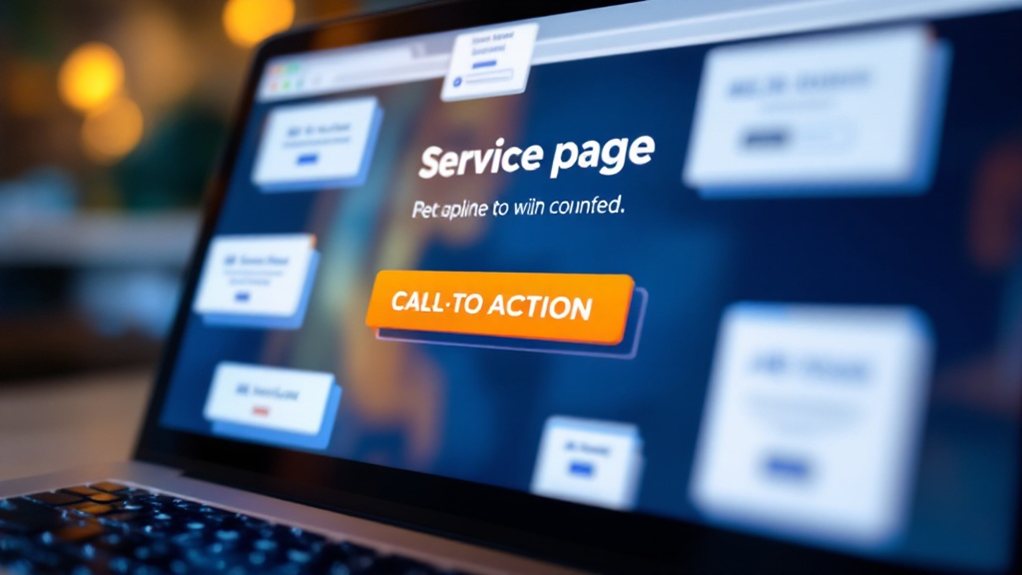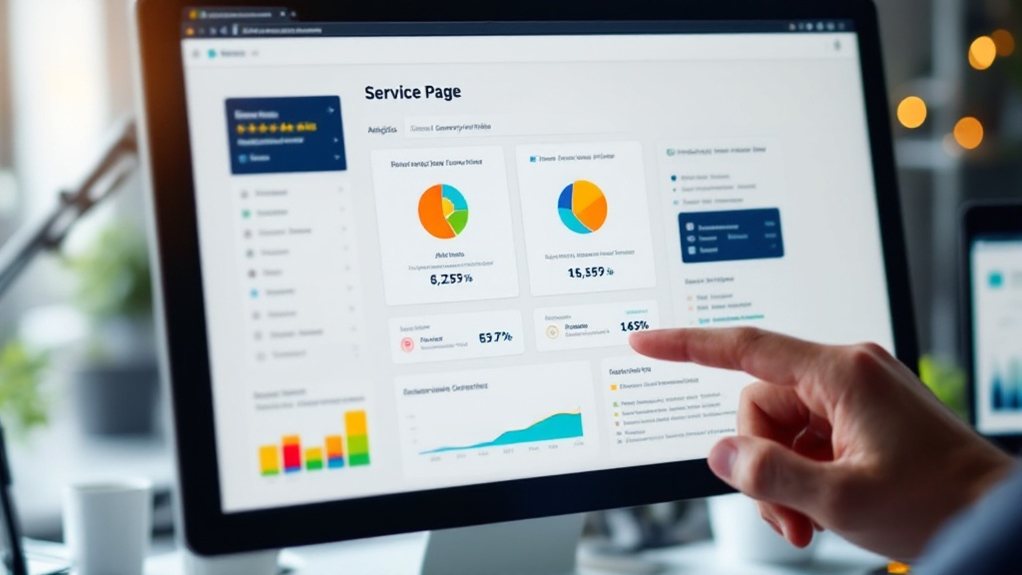To improve your service page conversions, craft a compelling unique value proposition that clearly differentiates your offering and addresses customer needs. Optimize your call-to-action design and placement with action-oriented language. Ensure your page is responsive and mobile-friendly, as over 59% of web traffic comes from mobile. Configure robust analytics tracking to monitor user behavior and leverage personalization to boost relevance. Continuously test and refine your strategies based on data-driven insights. There's more to discover about optimizing your service page for maximum conversions.
Crafting Compelling Unique Value Propositions

A well-crafted unique value proposition (UVP) is the foundation of effective service page conversions. To create a compelling UVP, focus on clarity, differentiating your offering, addressing customer needs, building credibility, and fostering an emotional connection. The best value proposition examples comprise critical components that resonate with the target customer and set the brand apart from competitors. Look to successful examples like Airbnb's emphasis on authentic local experiences or Slack's promise of improved team productivity. Craft your UVP with a customer-centric approach, conciseness, and a clear emphasis on benefits. Incorporate social proof and competitive analysis to strengthen your statement. Continuously refine and test your UVP using A/B testing, customer feedback, and market research to ensure it resonates with your target audience.
Optimizing Call-to-Action Design and Placement

Crafting effective call-to-action (CTA) designs and strategically placing them can significantly boost service page conversions. Use action-oriented language that compels users to click and take the desired action. Additionally, ensure your CTAs are visually appealing and well-positioned to maximize their impact. Personalized CTAs perform 202% better than non-personalized CTAs, so incorporating personalization can greatly improve CTA effectiveness.
Action-oriented Language
Action-oriented language is crucial when crafting effective call-to-action (CTA) buttons. Use verbs like "Get" and "Start" to motivate users. Write in the first-person point-of-view to increase engagement. Incorporate a sense of urgency with words like "Join" and "Create" to encourage participation. Stick to one main CTA per page to drastically improve conversion rates. Clear and concise CTA phrasing is essential. A/B test to determine what works best. Use action words to leave no room for confusion. Ensure the message aligns with user intent and clearly communicates the desired action.
Visually Appealing Placement
While placement is crucial, the visual appeal of your call-to-action (CTA) design also plays a significant role in driving conversions. Changing the color of the CTA button can increase conversions by 21%. Increasing the size of your CTA button can boost click-through rates by 90%, and using high-contrast colors can capture more attention. Employing whitespace highlights your CTAs and minimizes distractions, while strategically sizing them enhances visibility and user interaction. A larger CTA button attracts more attention and is more likely to influence the visitor to click. By optimizing the design and visual elements of your CTAs, you can significantly improve their effectiveness and drive more conversions on your service pages.
Ensuring Responsive and Mobile-Friendly Experiences

To ensure your service pages convert well, you'll need to optimize for mobile devices. Provide a consistent experience across all screen sizes by implementing responsive design principles like adaptive layouts and fluid menus. Utilize break points for seamless switching of desktop and mobile menus This will keep users engaged and guide them seamlessly through your content, no matter how they access your site.
Optimize for Mobile Devices
Optimizing your service page for mobile devices is a crucial step in enhancing its conversion potential. Over 59% of global web traffic comes from mobile, and 61% of mobile searchers are more likely to contact a local business with a mobile-friendly website. Responsive design ensures your site adapts to various screen sizes, improving usability. Mobile optimization boosts search engine rankings, as Google's mobile-first indexing rewards mobile-friendly sites. Mobile-friendly sites also boost search engine rankings thanks to Google's mobile-first indexing. Faster load times are essential, as slow pages can lead to high bounce rates. Simplify navigation, use large tap targets, and ensure high-contrast text to enhance the mobile user experience. With over 67% of users more likely to purchase from a mobile-friendly site, optimizing for mobile is a must.
Consistent Cross-Device Experience
With the prevalence of multi-device usage, ensuring a consistent user experience across different platforms is paramount. This can be achieved by implementing unified customer profiles, tailoring interactions based on device-specific habits, and leveraging omnichannel engagement strategies. Additionally, utilizing cross-device analytics tools and regularly testing the user experience are crucial steps. Forward stitching using Query Service can help trace the entire journey for a known customer_id, analyze the same customer on multiple devices, and apply the logic to customers without a CJA license.
| Benefits of Cross-Device Experience | Technical Challenges in Cross-Device Experience |
|---|---|
| Improved user experience | Non-persistent user data |
| Personalization opportunities | ECID/cookie limitations |
| Multi-device targeting | Stitching user journeys |
| Enhanced attribution | Reporting accuracy |
| Platform compatibility |
Addressing these challenges and adopting a consistent cross-device approach can significantly improve service page conversions and enhance overall customer engagement.
Responsive Design Principles
Why is responsive design a critical component of delivering effective service page experiences? As mobile devices account for over 62.71% of web usage, responsive design ensures your service pages adapt seamlessly across various screen sizes and devices. As of January 2025, mobile market share is greater than desktop and tablet combined. Key principles like fluid grids, optimized images, and media queries enable dynamic content flow for enhanced readability and usability.
Consider these responsive design best practices:
- Adopt a mobile-first approach to prioritize essential content and simplify navigation.
- Establish strategic breakpoints to adapt layouts for different screen sizes.
- Optimize page speed by compressing media and minimizing non-essential elements.
- Conduct rigorous cross-device testing to validate a consistent responsive experience.
Configuring Robust Analytics Tracking
Configuring robust analytics tracking is crucial for understanding how users interact with your service page and identifying opportunities for improvement. Start by setting up goals to monitor key actions like form submissions or button clicks. Leverage conversion tracking tools like Google Analytics to gain insights into successful user interactions. Configure different goal types to suit your needs, then analyze conversion rates to pinpoint areas for enhancement. Implement event tracking using tools like Google Tag Manager to monitor specific user actions. Combine this data with site search tracking to uncover user intent and interests. Ensure privacy compliance through first-party tracking and transparent data use. Leverage advanced analytics platforms for deeper user journey analysis.
Personalizing Content for Enhanced Relevance
Although content personalization may require additional effort, the benefits it provides for engagement and conversions are well worth the investment. By leveraging user data and behavior, you can deliver tailored experiences that keep customers engaged and guide them through their buying journey. Personalization is driven by data collected about each visitor, which is then used to provide a more relevant and engaging experience. Consider these strategies for enhanced relevance:
- Implement geolocation-based personalization to curate content and offers based on a visitor's location.
- Provide custom product recommendations using browsing history and preferences.
- Offer personalized discounts and promotions to increase engagement.
- Greet users with welcome messages that acknowledge their unique preferences.
Measure the success of your personalization efforts through engagement metrics, conversion rates, and customer feedback to continuously refine your strategies.
Accelerating Page Load Speeds for Better Conversions
To speed up your service page loads, optimize your assets and images. Leverage browser caching to reduce repeat requests. These techniques can significantly improve your conversions.
Optimize Assets and Images
Images can significantly impact your website's performance and conversion rates. Optimizing image formats, compressing file sizes, and ensuring responsive design are critical steps.
- Choose the right image format – JPEG for photos, PNG for transparency, and explore WebP and AVIF for superior compression.
- Compress images efficiently using tools like TinyPNG or Imagify to reduce file size without sacrificing quality.
- Adapt image sizes based on screen resolution with CSS for a seamless mobile experience.
- Include descriptive file names and alt text to enhance SEO and accessibility.
Continuously test and monitor image performance to balance quality and load speeds for optimal conversions.
Leverage Browser Caching
Browser caching is a powerful technique that can significantly accelerate your service page load speeds, leading to better conversions. By serving resources from the local cache instead of downloading them from the server, you can improve page speed, reduce server load, and enhance the user experience. Faster load times boost user engagement, retention, and conversions, especially on mobile devices. Implement browser caching by setting Cache-Control headers, using Content Delivery Networks, and versioning assets. Regularly monitor and adjust your caching strategies to maximize performance. Leverage this optimization to give your service pages a competitive edge and drive more conversions.
Leveraging Action-Oriented CTA Language
Crafting effective calls-to-action (CTAs) is paramount when optimizing service page conversions. Leverage clear, action-oriented language to prompt users:
- Use imperative verbs like "Buy," "Subscribe," and "Sign up" to provide direct instructions.
- Highlight the benefits and emotions that resonate with your audience, not just features.
- Ensure your CTAs stand out with contrasting colors, prominent placement, and mobile-friendly design.
- Instill a sense of urgency through limited-time offers, countdown timers, and emphasizing the advantages of quick action.
Streamlining Navigation and User Journeys
Optimizing your service page's navigation and user journeys is key to driving conversions. Use journey mapping tools like Mouseflow to visualize user paths and identify drop-off points. Simplify your navigation hierarchy, reduce complexity, and ensure responsiveness across devices. Employ visual cues and continuously test to refine the experience. Leverage behavioral data to pinpoint friction points and streamline user flows. Highlight relevant content and create feedback loops to meet evolving user expectations. Understanding your audience's needs is crucial – design every step of the journey with their preferences in mind. By enhancing the user experience, you'll see a boost in conversions on your service pages.
Incorporating Social Proof and Validation
Incorporating social proof and validation on your service pages can be a powerful way to build trust and drive conversions. Leverage these effective strategies:
- Showcase real-time notifications to create a sense of urgency.
- Prominently display customer reviews and ratings to boost credibility.
- Incorporate user-generated content and expert endorsements to establish trust.
- A/B test different social proof formats to determine what resonates best with your audience.
Continuous A/B Testing and Optimization
Continuous A/B testing is the cornerstone of optimizing your service page conversions. By identifying which version of elements like headlines, images, and pricing strategies enhance engagement, you can make data-driven improvements. Design tests by dividing traffic between a control and variant, then collect crucial metrics like conversions and click-throughs. Analyze the results to determine the winner that boosts conversion rates. Leverage research-informed hypotheses, focusing on high-priority user pain points. Continuously iterate based on test outcomes, integrating analytics tools to monitor performance. Embrace incremental changes and leverage insights to enhance the user experience and inform future product development. With a strategic, data-driven approach, you can systematically optimize your service pages for maximum conversions.
